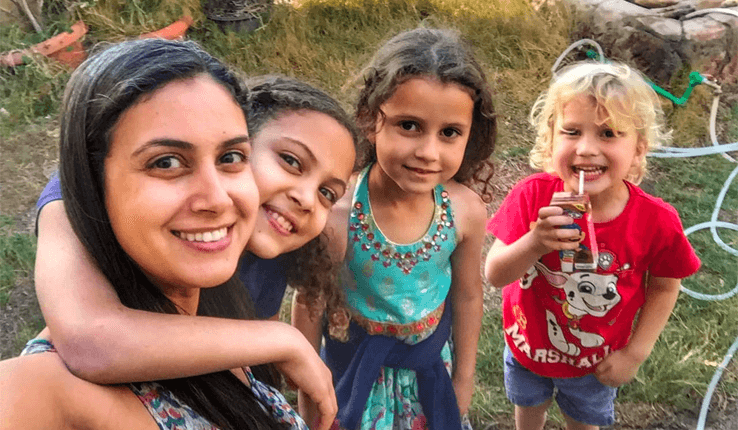When the lockdowns started in early 2020, Yasmine Tarek was stuck at home with three kids and increasingly severe anxiety.
Instead of shutting down her fitness business, she got the problem diagnosed, went on medication, and ramped up.
She tripled the price of her 12-week transformation program in the middle of the pandemic, and doubled her business.
Every personal trainer has a story of struggle, of starting at the bottom and wondering where they’d find their next client. And when COVID-19 struck, even the most successful ones found themselves scrambling to save their businesses.
Tarek’s story stands out because she’s done it so many times.
In the summer of 2018, for example, her situation was dire:
- She was a newly divorced single mom, with three kids between two and seven years old.
- She’d recently moved to a new city.
- Most of her clients were on vacation, and she had bills to pay.
That’s when, out of desperation, she trained her first online client.
By 2020, she was working with more than 100 online clients.
Here are four important lessons from Tarek’s transition from overworked and underpaid to thriving, and how she did it in the middle of a pandemic with three kids at home and struggling with her own anxiety.
Lesson #1: Train yourself first
You’ve probably heard the advice to “pay yourself first.” The idea is to put off discretionary purchases until you’ve met your savings goal.
The same applies to fitness pros.
The best coaches are often the ones who helped themselves first. That is, they used their own training to overcome a challenge.
Tarek is a perfect example. She grew up in Egypt with a father who was an architect and a mother who’d studied French literature. Although she was an avid runner and swimmer, she never imagined a career in fitness.
That changed in her junior year of college when she got a part-time job as a cartoonist. “I had to sit at a desk for eight hours drawing,” which led to constant back and neck pain, she says.
That’s why she joined a Gold’s Gym in Cairo. “I decided I wanted to learn more, and got my first certification in 2005.”
The gym offered her a part-time job, which became full time a year later, after she graduated with a degree in communications.
She’s still a trainer 15 years later. All because her desk job was a pain in the neck.

During the pandemic, Yasmine Tarek livestreamed workouts for her audience four days a week.
Lesson #2: Every crisis is an opportunity
In the future, we may talk about the fitness industry as BC and AC:
- BC is before COVID-19, when most coaches worked with their clients primarily in person.
- AC is after COVID-19, when most coaches offer their clients an online training option, and many don’t train anyone in person.
The lesson we’ll take away from the pandemic, and pass on to future trainers, is that gyms can close without warning, and we have to be prepared by becoming online trainers.
Tarek was prepared for the shutdown in 2020 because it wasn’t her first crisis. It was, in fact, her third.
The first came in early 2011, when she closed the gym she’d recently opened, delivered her first child, and divorced her first husband—all coinciding with the Egyptian revolution and the resulting economic chaos.
The second crisis came in 2018. She had recently separated from her second husband and moved with her three children to Hurghada, a resort town on the Red Sea.
With most of her one-on-one clients out of town that summer, she announced a group challenge on social media.
The good news: She got a lot of interest.
The bad news: Most of the interest came from people in Cairo, 300 miles away.
“I responded that I would get back to them that evening with details of an online program,” she says. But when she did, none of them actually signed up for it.
“I knew people would be skeptical,” she says. “Online training was not very common here in Egypt. I personally was skeptical.”
A week later, a friend put her in touch with a woman who was looking for an online coach.
Tarek landed the client, even though she hadn’t yet come up with a training or nutrition plan.
“I just had an outline and photos from an ebook I was planning to do,” she admits. “I told the woman, ‘Give me 48 hours, and I’ll have your program ready.’ I sat down for 10 hours, two days straight, coming up with the program for this woman.”
The client got the results she wanted. Tarek shared them on Facebook and Instagram, and more clients signed up.
“Two years later,” she says, “I have 121 members in my group.”

Whether she’s giving advice or demonstrating exercises, Tarek’s kids are rarely far away.
Lesson #3: You don’t know what you don’t know
So how did Tarek go from one online client to 121 in two years? Especially when she and her client base were initially skeptical?
Her first step was to join Online Trainers Unite, the Facebook group of the Online Trainer Academy Level 1 Certification.
“I was so happy to see there was a big community of people who were doing the same thing and getting great results with their clients, and that it works,” she says. “I remember thinking, ‘This is exactly what I need.’”
For her first 18 months as an online trainer, she figured things out her own, and mostly got things right.
Her clients buy a 12-week group transformation program, rather than individual month-to-month training. That means she sells a result, which allows her to charge more.
(She also trains a couple of clients in person just because she enjoys it.)
But she didn’t know what her business was missing until she enrolled in OTA Level 2 in early 2020. Tarek was the first OTA 2 student who hadn’t previously completed the OTA 1 certification.
“I was just winging things,” she says. “What I needed OTA 2 to give me was a proper system so I’m not just guessing if this works or if it doesn’t.”
Here’s a short list of what she got from the program:
- The confidence to raise her prices. “I’ve managed to triple my prices since I started OTA 2,” she says.
- More efficient and effective customer service—“giving more care to my clients without giving more of my time.”
- A legacy program, which allows clients to continue training with her after they finish the 12-week transformation. That reduces the number of new clients she needs to bring in.

Every parent knows the feeling of moments like these, when everyone’s smiling and your challenges seem insignificant. You have to enjoy them when you can, because they never last long.
Lesson #4: What you take away from your clients is just as important as what you give them
Tarek trains moms, finding new clients all the usual ways: Facebook, Instagram, customer referrals, personal connections, friends of friends …
“Ninety-nine percent of the women who get in touch with me want to strengthen their abs, work on their posture, and lose a bit of weight,” she says. “My program covers all of these things.”
But while her program helps them exercise more and eat better, it also aims to relieve some of the stress her clients feel.
“This is the one thing that resonates with moms the most,” she says. “They already have a lot of stress on a daily basis.”
Part of her appeal is the fact she’s just as stressed as her clients, as she shared in a recent Facebook post:
“I'm tired. I'm tired of being the only grown-up in a household of four humans and three cats. I'm tired of running a one (wo)man show.
I'm tired of hearing how you think I'm so strong or so inspiring. Today I'd give that up in exchange for an easier day.”
But if nothing else, the day at least provided her some entertainment value, when one of her kids walked into the room naked while she was on a Zoom call with a client, which she revealed in a post a few hours later:
That brings us to one final lesson from Tarek:
The more you have in common with your clients, the less explaining you have to do when things go sideways.










